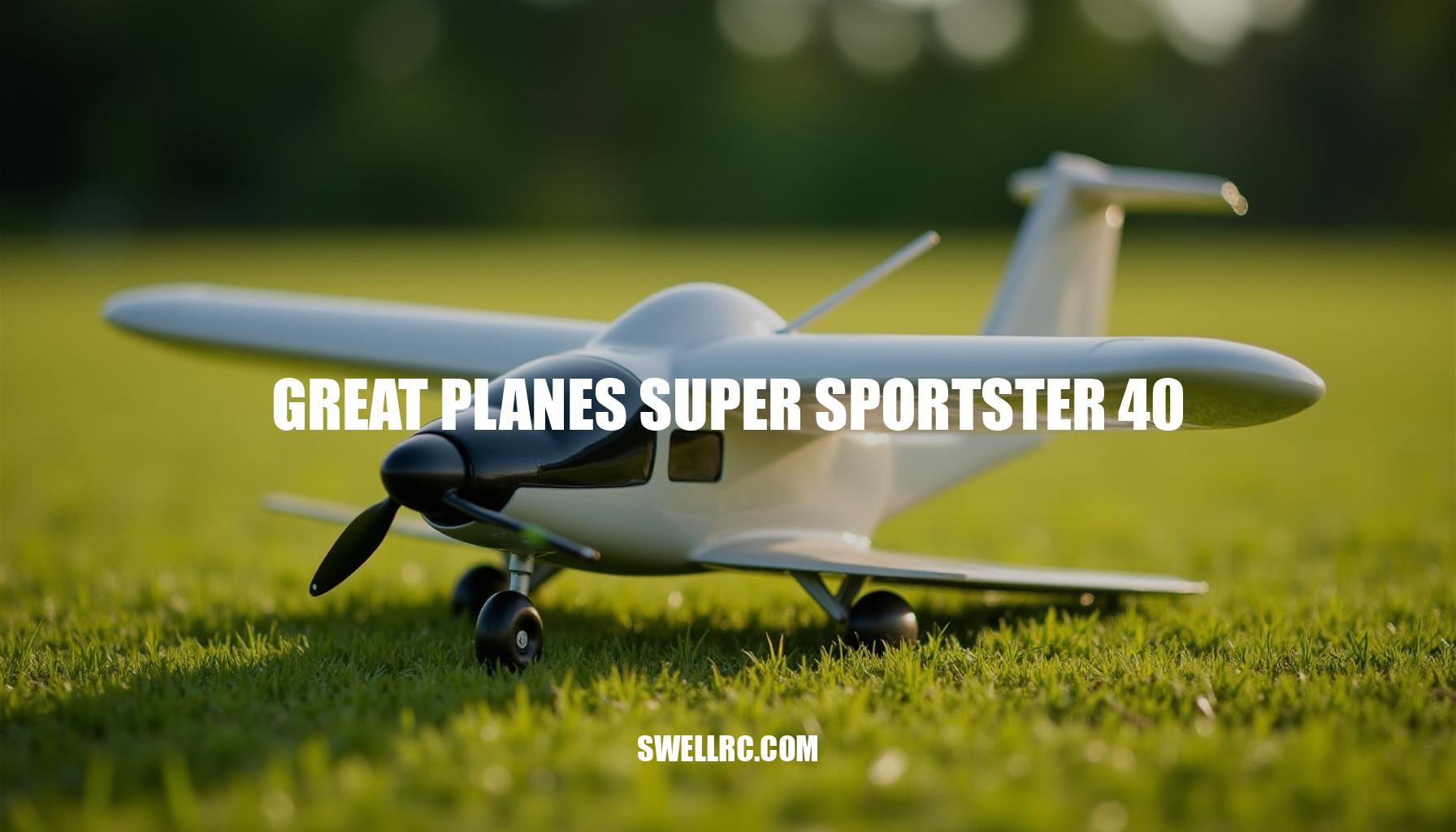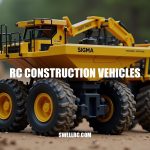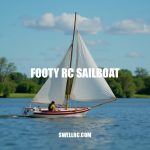Great Planes Super Sportster 40 Review
I kept seeing the Great Planes Super Sportster 40 pop up in RC legend threads—old-timers praising its manners, newer pilots restoring them like museum pieces. I just had to find out why this model keeps surfacing in classic RC planes forums. After a few weeks digging through build logs and flying a well-kept example, it clicked: the Super Sportster 40 blends honest balsa RC plane craftsmanship with a flight personality that still feels fresh.
It’s agile without being twitchy, durable without being heavy, and simple to build yet refined in the air. Think of it as the sport model aircraft you grow into and never outgrow.
Along the way I revisited related designs to frame its place in history. If the Super Sportster is the approachable sports car, the Great Planes Ultra Sport is the sharper, track-tuned sibling with pattern roots (see: Great Planes Ultra Sport).
It also sits comfortably alongside storied kit lines from brands many of us collect, right down the shelves next to Aeroworks and Black Horse favorites. It shares a building ethos you still see in World Models radio-controlled airplanes. This article is part research journey, part hands-on review—aimed at helping you decide if this classic glow engine RC plane deserves a spot on your bench or in your hangar.
The Design Story: Why the Super Sportster 40 Became a Legend
The more time I spent with the Super Sportster 40 kit parts, the more I realized how purposeful the Great Planes Super Sportster 40 design really is. I couldn’t believe how refined the wing and fuselage geometry felt—light, clean, and built for speed with stability. Underneath the covering lies a well-thought-out structure featuring balsa construction techniques that create a built-up balsa and plywood framework.
This results in a light yet tough fuselage complemented by a reinforced landing-gear block to enhance durability and performance.
The semi-symmetrical wing is moderately thin with gentle taper and elliptical tips, expertly designed to optimize efficiency and provide smooth stall behavior. The taildragger stance, combined with ample rudder authority and strip ailerons, offers crisp roll response without over-sensitivity, contributing to an agile yet stable flight experience. This RC aircraft is tailored around .40 size RC planes powerplants, typically supporting .40–.46 two-stroke or .48–.52 four-stroke engines, delivering a lively sport performance without excessive weight.
What makes the Super Sportster 40 fly so well is its semi-symmetrical airfoil design coupled with modest wing loading, which ensures forgiving low-speed handling while maintaining straight tracking at higher speeds. The sleek canopy and turtledeck reduce drag thanks to a low frontal area, allowing the plane to carry energy efficiently through aerobatics. Additionally, generous tail volumes stabilize pitch and yaw, making it an excellent option for newer sport fliers to build confidence.
For perspective, while composite thoroughbreds like CARF’s pattern ships push stiffness and precision to the maximum, and modern wings like the HeeWing F-01 (https://www.swellrc.com/heewing-f-01/) showcase advanced efficiency in foam/composite designs, the Super Sportster 40 stands out by hitting a timeless middle ground. It combines the classic wood feel with durable RC aerostructures and performance that still impresses today.
Building and Setup Experience: My Personal Take
After one late night gluing the fuselage, I realized the magic isn’t just in how it flies—it’s in how it teaches. The Great Planes Super Sportster 40 rewards careful alignment and covering, and it’s friendly to both glow and electric power if you plan the balance thoughtfully. Whether you’re exploring how to build a Great Planes Super Sportster 40 or looking for a comprehensive Great Planes Sportster 40 setup guide, the process enriches your skills in balsa construction techniques and offers insights into RC plane building tips that are invaluable, especially for handling .40 size RC planes.
| Super Sportster 40 Build Checklist | |
|---|---|
| Materials | Balsa and ply kit parts, epoxy/CA adhesives, hardwood triangle stock for firewall, light fiberglass cloth for gear block reinforcement |
| Tools | Flat building board, pins, sanding blocks, incidence meter, covering iron/heat gun, drill press (helpful), metric/imperial drivers, fuel-proof paint or film |
| Timeframe | 25–45 hours for experienced builders; additional time for film schemes and fiberglass glassing |
| Power Choice | Glow engines: .40–.46 two-stroke or .48–.52 four-stroke; Electric: roughly 700–900 W equivalent outrunners |
The electric RC conversions are particularly rewarding. Reinforce the firewall and add an internal battery tray with positive retention; proper ventilation for the cowl and air exit is vital. A 4S LiPo pack between 3300–5000 mAh paired with a 700–900 W outrunner motor and a 60–80 A ESC offers excellent sport performance.
Properly selecting and balancing the propeller ensures efficient current draw and cooling.
For glow-powered setups, position the fuel tank centerline near the carburetor for reliable runs. If vibration surfaces, consider soft-mounting the engine to preserve the airframe’s integrity. Starting with a sport prop in the 10×6 to 11×6 range on a .46 two-stroke engine is a dependable choice, but watch for spinner and muffler placement so they don’t shift the CG too far forward.
Balancing your model at the plan’s recommended CG before the maiden flight is critical; if you’re new to .40 size RC planes or low-wing sport models, adding a slight nose bias helps with stability. For radio setup, moderate control throws with 25–35% exponential on ailerons and elevators work well, while the rudder can tolerate slightly larger throws for ease in takeoffs and landings.
When refining your hardware and finishing touches, exploring examples of well-finished radio setups on Esprit RC planes can provide excellent inspiration. Similarly, the meticulous craftsmanship emphasized in Top Model sailplanes—notably their light yet strong structures and flawless covering techniques—translates beautifully to building the Super Sportster 40, helping elevate your skills in balsa construction techniques.
Flight Performance: Testing What This Plane Can Really Do
On a calm morning with a gentle 5–8 mph breeze down the runway, the Super Sportster 40 flight test begins smoothly. The tail lifts quickly, and with a slight nudge of right rudder, the plane tracks straight without fuss. The rotation feels seamless—no drama, just that classic leap typical of Great Planes aerobatic RC planes signaling it’s ready to play.
Once airborne, the sport model flight performance impresses: the ailerons offer crisp but not snappy control, enabling axial rolls that require a subtle down elevator input when inverted, reflecting the advantages of a semi-symmetrical wing design. Mid-throttle cruising is stable, and the plane accelerates cleanly without speed hunting, maintaining energy admirably through large, round loops and steep 45-degree uplines—superior expectations for a wood sport model.
Exploring the stall behavior, power reduction and nose-high attitude induce gradual buffeting, with a straightforward stall break ahead and quick recovery, fostering confidence especially among newer sport pilots. Aerobatic maneuvers such as big loops, point rolls, Cuban eights, stall turns, and lazy snaps are well within the aircraft’s capability; while not a 3D specialist, it executes these with graceful precision.
Landing phases reveal a stable float on final approach, and holding just a whisper of power while maintaining centerline flight helps stick the mains consistently. This reflects excellent control responsiveness in varied flight regimes.
| Aspect | Pros | Cons |
|---|---|---|
| Stall Behavior | Forgiving stall entry and quick recovery | None significant |
| Speed Range | Broad, smooth energy management throughout envelope | Not optimized for extreme pattern speeds |
| Tracking and Control | Honest straight-line tracking and easy orientation | Requires mindful CG placement with heavy engines/batteries |
| Landing Gear | Robust gear block and spars | Wheel pants fragile on rough terrain |
In summary, the performance review highlights a plane well-suited for pilots seeking stable yet responsive handling without the intensity of pure pattern or 3D models. For enthusiasts who appreciate a warbird-like presence combined with calmer operation, the F4F Wildcat RC airplane offers a compelling alternative. Additionally, to refine your energy management skills across multiple engine types, observing the throttle coordination and inertia handling demonstrated by the Avios C-130 RC plane can enhance smooth flying on sport models like the Super Sportster.
Comparing the Great Planes Super Sportster 40 to Other Models
After flying and researching extensively, including benchmarking against popular aerobatic RC models, here’s a quick high-level comparison of some top sport model aircraft:
| Feature | Great Planes Super Sportster 40 | Great Planes Ultra Sport | Black Horse RC Planes (Sport Models) |
|---|---|---|---|
| Build Difficulty | Intermediate | Intermediate-plus (tighter tolerances) | Easy to Intermediate |
| Stability vs. Agility | Slightly favors stability | Favors agility and precision | Balanced for everyday flyers |
| Aerobatics | Graceful IMAC-lite routines | Leans toward pattern crispness | Lively but approachable maneuvers, varies by airframe |
| Materials | Balsa/plywood kit | Balsa/plywood kit | Mostly ARF balsa/ply with modern hardware |
For those considering Great Planes Ultra Sport vs Super Sportster, the choice comes down to your priorities: the Super Sportster offers a forgiving, classic kit perfect for learning, while the Ultra Sport suits pilots seeking sharper aerobatics—with a bit more complexity in build difficulty due to tighter tolerances. Meanwhile, Black Horse RC planes provide a great balance for flyers who want to build less and fly sooner, as many of their sport model aircraft are ARFs designed for accessibility without sacrificing performance.
If you’re after composite precision, dive into CARF RC planes to see maximal stiffness and accuracy in aerobatic RC models (see CARF RC planes). For those who prefer high-quality wood ARFs that still deliver a builder’s grade feel, the heritage of Aeroworks RC planes is a fantastic benchmark (explore Aeroworks RC planes).
Ultimately, comparing these RC legends reveals the Super Sportster’s secret: amazing balance. It forgives beginner errors, teaches foundational skills, and rewards finesse when you’re ready to push the limits—making it a standout choice in sport model aircraft.
Where the Super Sportster 40 Fits in Today’s RC Community
Even as foam and composite ARFs dominate the modern RC landscape, the Great Planes legacy embodied by classic RC planes like the Super Sportster 40 remains deeply relevant. This model represents the heart of the kit building culture—where patient hours of pinning ribs, sanding sheeting, and understanding the nuances of incidence and CG translate into invaluable flying experience. Balsa kit enthusiasts cherish these lessons, as they teach essential skills in structure, trim, and repair that benefit every pilot, no matter the airframe they fly.
Moreover, the RC community actively keeps these iconic models alive through various activities, including:
- Restorations and plans redraws that refine and preserve the original designs
- Swap meets that foster the exchange of rare parts and knowledge
- Shared insights that lower the barriers for first-time kit builders, enriching mentorship traditions
New and like-new wood ARFs from makers like World Models continue to offer an approachable introduction to traditional balsa construction, blending classic charm with modern convenience (https://www.swellrc.com/world-models-rc-planes/).
While contemporary designs illustrate how the craft is evolving, the Super Sportster’s timeless appeal confirms that good geometry paired with light wood construction still creates pure flying magic.
Conclusion: What the Great Planes Super Sportster 40 Taught Me About Flying
After weeks of meticulous adjustments, the Great Planes Super Sportster 40 truly showcased its enduring appeal as a classic sport model that subtly enhances RC pilot skills. Its precise flight balance allows it to roll smoothly for neat lines, slow down gracefully for satisfying landings, and forgive the occasional imperfect flare. This experience reaffirmed that timeless design and solid building practices stand the test of time beyond fleeting trends.
If you’re seeking kit building motivation to embark on a project that deepens your expertise, this classic is a commendable path — whether you opt to chase down a kit, restore an existing airframe, or create a build inspired by its legacy.
For those ready to explore kindred spirits that offer fast, clean fun with reduced build time, Black Horse RC planes provide a smart, exciting next step.
Whichever route you choose, each flight promises to return you to the skies a little better than when you launched, embodying the true spirit of mastering your craft.
Frequently Asked Questions
- What makes the Great Planes Super Sportster 40 a classic RC plane?
It pairs a time-tested balsa/ply structure and semi-symmetrical wing with approachable .40-size power, delivering smooth tracking, forgiving stalls, and graceful sport aerobatics. It’s easy to live with, tough enough for regular flying, and rewarding to build—traits that made it a staple in club hangars for decades. - How difficult is it to build and fly the Super Sportster 40?
Build difficulty is intermediate: straight ribs, simple sheeting, and a conventional taildragger layout are friendly if you’ve finished at least one trainer or ARF. Flying is second-airplane territory—stable and predictable with moderate throws and correct CG, yet lively enough to keep you engaged as skills grow. - What engine size fits the Great Planes Super Sportster 40 best?
A .40–.46 two-stroke or a .48–.52 four-stroke is the classic match. Keep total weight reasonable to preserve the model’s easy handling. Typical sport props are 10×6–11×6 for a .46 two-stroke and around 12×6 for a .52 four-stroke; always confirm clearances and follow the kit’s recommendations. - Can the Super Sportster 40 be converted to electric power?
Yes. Reinforce the firewall, add a secure battery tray, and ensure cooling air in/out. A 4S setup in the 700–900 W range with a 60–80 A ESC and an appropriate prop delivers glow-like performance. Balance at the manual’s CG and verify current/temperature on the bench before flying. - How does the Super Sportster 40 compare with other sport models like the Great Planes Ultra Sport?
The Ultra Sport is crisper and more pattern-oriented with a fully symmetrical feel, while the Super Sportster 40 is slightly more forgiving and floaty. If you want maximum precision and sharper snaps/point rolls, pick the Ultra Sport; if you want confidence-building sport aerobatics and easy landings, pick the Super Sportster. - What kind of flying experience should you expect from the Super Sportster 40?
Smooth, confidence-inspiring sport flying: straight tracking, predictable stalls, big round loops, tidy rolls, lazy snaps, and satisfying, low-stress landings. It’s not a 3D or speed ship, but it covers the classic aerobatic envelope beautifully. - Which other RC plane brands offer similar flight characteristics?
Look at sport models from Black Horse and World Models for approachable balsa/ply airframes, and legacy Aeroworks designs for high-quality wood ARFs. Each offers stable, engaging sport performance with varying levels of build effort.



